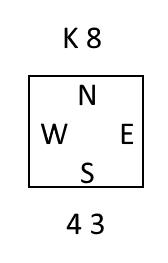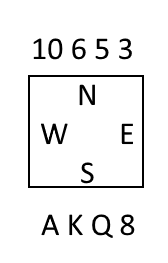How To Finesse In Bridge
Bridge Finessing
The art of making an extra trick by taking advantage of the favourable position of a high card held by the opposition. This article will help you with understanding finesse in bridge.
What does that mean?
Finessing is done by declarer playing either from hand or from dummy (ie you need to be able to see two hands to finesse)
So, suppose that you are South and you can see these cards in a suit that you want to use for the finesse:

Is it possible to make a trick with the King?
What will happen if you lead the King? It will lose because whichever opponent holds the A will play it.
What will happen if you lead one of the small cards from hand? Can you win with the King? You have a 50-50 chance. If W holds Ace, you can make a trick with K. If E holds ace there is nothing you can do.
How can that work?
You lead one of the low cards from hand and see what West plays:
- If W plays the Ace, you play a low card from dummy, keeping the king which will be a winner next time the suit is played.
- If W plays a low card you play K, hoping that W also has the ace but didn’t play it. If this turns out to be correct, you will win with the King. (Of course if East has the Ace, your king will lose. As I said above, the bridge finesse odds are 50-50. But that is better than leading the King where the chance of winning is zero unless the opposition have a good reason for forcing you to with with the King.)
So the basic principle of finessing is to lead low TOWARDS the honour you hope to make, knowing that it will work approximately 50% of the time.
The Marked Finesse
With the regular finesse described above, you can’t be sure that it will win. With a marked finesse you are sure of winning.
What is a marked finesse?
The marked finesse happens when one opponent has shown out of cards in the suit. You then know which cards the other opponent holds and can take advantage of this.
Suppose you hold these cards in the suit:

Can you make 4 tricks? (Assuming you are playing in NT or have drawn trumps)
If the remaining cards break 3-2 between the opponents you will always make 4 tricks, Likewise if they break 4-1 with the singleton being the Jack.
But suppose the singleton isn’t the Jack or the cards break 5-0? This is where you use the marked finesse.
Imagine you’ve played one round of the suit and W played 9. You try a second round and W discards. You now know that E holds the J & 7.
How does the marked finesse work?
As with finessing above you need to lead TOWARDS the honour you want to make. If you lead Q from hand, then W will play the 7 and keep J for the next round.
You need to cross to dummy – this is where forward planning helps, as you would have kept entries to dummy if possible.
Once in dummy you lead a low card towards your hand. You know E holds J and 7.
- If E plays 7 you win with 8. Your Q will win next time
- If E plays J you play Q. Your 8 will win next time.
You can practice finessing if you join No Fear Bridge for your two week trial membership.
Acol bridge players join HERE.
American Standard bridge players join HERE.
